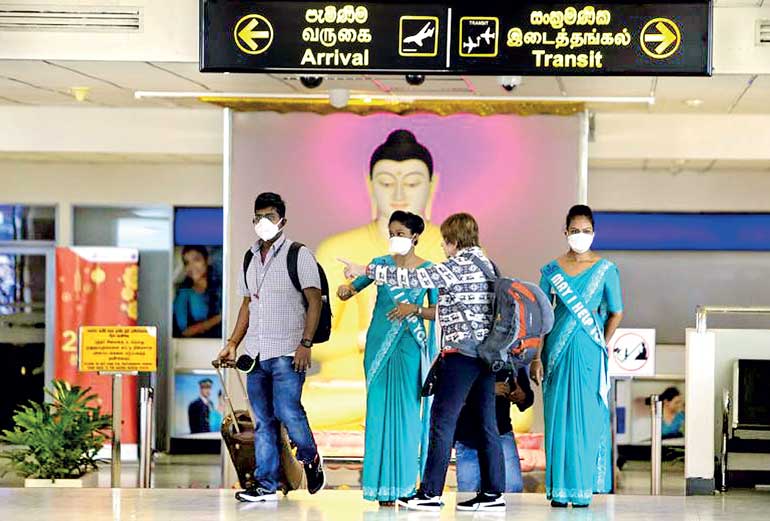Monday Apr 21, 2025
Monday Apr 21, 2025
Tuesday, 15 February 2022 02:34 - - {{hitsCtrl.values.hits}}

The tendency to travel to attend events, both on the part of dedicated event tourists who are motivated to travel for specific events and on the part of casual event tourists who are not motivated to travel for certain events, is referred to as event tourism.
The event industry is a dynamic and rapidly expanding industry with obvious tourism synergies. Events have the ability to enhance the visitor economy, offer media attention, promote development, and drive infrastructure upgrades, including the formation of new partnerships, when they are well-hosted.
The main tourism goal for events is to attract more tourists (especially during off-peak seasons) to serve as a catalyst for urban renewal and to improve the destination’s infrastructure and tourism capacity in order to foster a positive destination image, which helps to animate general place marketing.
The most well-known occurrences on a global scale include: Carnival in Rio de Janeiro, Brazil. The Rio Carnival is the celebration to end all parties, with its bright, impossible-to-miss display of lights, colour, music, and dance. China’s New Year, the Netherlands’ Queen’s Day, the United States’ Super Bowl, and Scotland’s Hogmanay.
At this time, there is a strong link between the tourism and event industries. Over the last few decades, the event sector has made significant strides. By 2025, the MICE (Meetings, Incentives, Conferences, and Exhibitions) tourism market in Sri Lanka is estimated to reach $ 285 million. So, the question is whether Sri Lanka arrived at that tragedy through traditional means or whether they need to rethink some creative activities in order to attract more tourists, particularly those who have never visited Sri Lanka.
The most well-known events in Sri Lanka include, religious festivals:
The Duruthu Perehera – The Duruthu Perahera is a magnificent temple parade that takes place every 2,500 years to commemorate Lord Buddha’s first visit to Sri Lanka. The Kelani Perahera takes place every year in the month of Duruthu (January), just before the full moon, at the Kelaniya temple in Colombo),
The Navam Perehara – The Navam Maha Perahera, which is hosted in Colombo, is identical to the famed Kandy Perahera celebration. This vibrant and unique Sri Lankan event has over 5,000 performers, including dancers, acrobats, drummers, torch
bearers, and more.
The New Year Festival – On 1 January, many countries around the world celebrate the start of a new year. However, different calendars all across the world celebrate different days to greet the New Year. Sri Lankan new year celebrations begin on 13 April and end on 14 April. New Year’s Day in Sinhala and Tamil. One of the must-do activities during your visit to Sri Lanka is to attend the country’s largest festival, which includes a plethora of traditions and customs. Sri Lankans celebrate the new year in April with a lot of firecrackers, pyrotechnics, and consumption of traditional delicacies, based on the sun’s movement from the Meena Rashiya (House of Pieces) to the Mesha Rashiya (House of Aries). The Sinhala and Tamil new year, also known as the sun festival, is a centuries-old tradition done to honour the God of the Sun.
Vesak – Vesak, also known as Wesak or Buddha Day, is one of the most major Buddhist festivals, held in May or early June.
The Poson Festival – The introduction of Buddhism in Sri Lanka in the 3rd century BC is commemorated on Poson full-moon poya day (Poson Poya Day, Poson Celebration), a festival of significant historical and theological significance observed island-wide by Buddhists. Poson, performed on the full moon day of June, commemorates the conversion of King Devanampiyatissa to Buddhism by Arahat Mahinda, son of Emperor Asoka of India, almost 2,000 years ago. Mihintale, the historic monastery complex where the royal missionary monk Mahinda preached the first sermon to the ruling king, and Anuradhapura, the ancient capital, are the two primary centres of celebration. The events include mass religious observances and illuminations pageants.
Esala Perehara in Kandy – Dancers, jugglers, musicians, fire-breathers, and lavishly painted elephants perform at the Esala Perahera in Kandy, one of Sri Lanka’s oldest and biggest Buddhist festivities. This is conducted in Esala (July or August), the month in which the Buddha is said to have given his first teaching after attaining enlightenment. The Kandy Esala Perahera lasts 10 days, with a variety of celebrations taking place throughout. A procession of musicians, dancers, singers, acrobats, and other entertainers, accompanied by a huge number of caparisoned tuskers and elephants, parades the streets in celebration of a religious occasion in Sinhalese.
Bellanwila Perehera in Colombo – For the last 70 years, the Bellawila Raja Maha Vihara’s Bellanwila Esala Perahera took to the streets in all its splendour. The perahera, which began in 1950 to bring blessings to people and their cattle in the Bellanwila area who were suffering from starvation and epidemics, has grown into a month of religious and cultural festivals, including a week of distinct peraheras.
To establish new events within our legal, custom, and tradition framework while maintaining our unique personality, we must think beyond the box.
Pros of Event Tourism can be identified as: Attracting a huge number of people before, during, and after the event who would not have come otherwise, increase the amount of money spent by tourists, create a positive image of the host country and a high level of international awareness.
Develop supply and infrastructure that will allow the region’s economy to grow indefinitely.
Cons are Events Tourism has the potential to harm the environment by causing erosion, pollution, the loss of natural ecosystems, and forest fires. Cultural conflicts, service economy, seasonal fluctuations, imbalanced funding, foreign poaching and tourism dependence.
The Kandyan dances of the Hill Country, known as UdaRata Natum; the low country dances of the southern plains, known as Pahatha Rata Natum; and Sabaragamuwa dances, or Sabaragamuwa Natum are the three main genres of Sri Lankan classical dance. Traditional Sri Lankan festivities should be held in a massive festival. It could be a seven-day festival in Colombo, Negombo, or Hikkaduwa. The majority of foreigners are welcome to attend. Nadagam, kolam, sokari, Angam, Ilangam also can be part of the events.
In Sri Lanka, Thovil is a traditional event in which a priest and his assistants exorcise mental or physical disease. A Thovil troupe of dancers and drummers performed under the auspices of the Asia Society’s performing arts program, providing just enough fire eating, torch twirling, and masked dancing for a layman to get a sense of the flavour of a colourful folk ritual whose magic and purpose does not preclude entertainment.
A traditional Sinhalese exorcism ceremony known as Sanni yakuma or Daha ata sanniyas. The rite includes 18 masked dances, each symbolising a different human illness or ailment. The principal dances of the Pahatharata, or low country, dancing form, which is one of Sri Lanka’s three main dancing forms, are these 18 dances. The ceremony summons the demons believed to be responsible for the patient’s illness, who are then admonished not to bother humanity and expelled.
The presence of international musicians and personalities ensures the success of the event. Celebrity branding, also known as celebrity endorsement, is a type of advertising campaign or marketing technique that employs a celebrity’s celebrity or social standing to promote a product, business, or service, or to increase public awareness of a cause. Marketers employ celebrity endorsers in the hopes that the celebrity endorser’s good image will be transferred to the product or brand’s image. Celebrities are also used by non-profit groups because their regular media coverage reaches a larger audience, making them an excellent fundraising tool.
International conventions of Lions Clubs International which are held every year can be directed to Sri Lanka where Lions from 210 countries all over the world get together. They Enjoy live music and entertainment from top performers from across the world, they Join fellow Lions and Leos in the Parade of Nations to celebrate cultural diversity. In expert-led seminars, Lions learn and grow their skills. Hear from some of the world’s most illustrious speakers. Meet with Lion Clubs International personnel to discuss ways to improve their service, generate new possibilities, gain access to important resources, they will be able to vote in the International Election if they are a delegate for their Lions Clubs.
The Amazing Race brand can be licensed to a local event with worldwide participants. The Hambantota Formula 1 track project must begin right away. It contributes to the growth of tourism in the southern region.
Everyone’s ticket pricing should be the same. There shouldn’t be two prices for locals and visitors. Tourists will come if it is equal or greater. Tourists are now flocking to Pidurangala instead of Sigiriya. It is because of the cost. Other places are the same as well. They will spend in other areas if ticket prices are reasonable. It contributes to the expansion of the economy.
For a sustainable environment, a major event is an entire country being cleaned on the same day. It doesn’t have to be on Earth Day. Every Sri Lankan, whether in the private and public sectors, should take part in this. The government can declare this day a national holiday for all industries.
I may propose a local event as an example, Sri Lankans believe that their indoor garden landscaping is sufficient. Outside, Pradeshiya Sabawa (Local Authority) owns the land. We can organise the event at the Pradeshiya Sabha level, at the district level, and choose a winner for outdoor landscaping every year. It contributes to more sustainable living and the country’s beauty. One street, all of the houses on it, can have a big impact on their neighbourhood.
(The writer holds a DBA (Tourism and Hospitality Management), and is a Senior Lecturer at Business School, Sri Lanka Technological Campus (SLTC).)